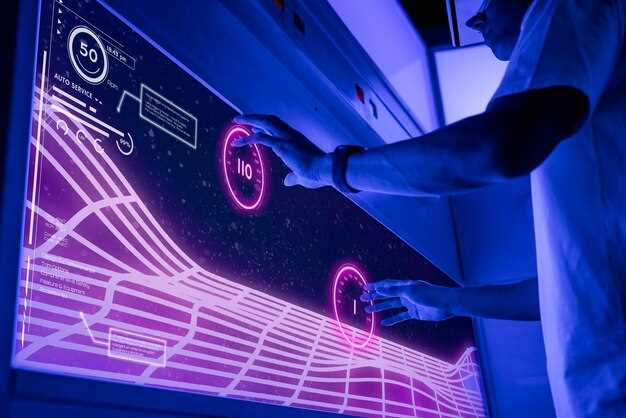
In recent years, the integration of Augmented Reality (AR) into various sectors has revolutionized how users interact with data. One of the most significant advancements is the emergence of AR dashboards, which seamlessly blend digital information with the physical world. These innovative tools offer an immersive experience, allowing users to visualize complex datasets in a more intuitive and engaging manner.
The rapid growth of AR technology has been fueled by advancements in software development, improved hardware capabilities, and an increasing demand for more interactive user experiences. As industries recognize the value of data-driven decision-making, AR dashboards have become essential for professionals seeking to enhance their analytical capabilities. By providing real-time data visualization in a spatial context, these dashboards empower users to make informed choices more efficiently.
Furthermore, the rise of mobile devices and smart glasses has made AR technology more accessible than ever. Businesses are discovering that enhanced data visualization through AR not only improves user engagement but also promotes better collaboration among teams. As we delve deeper into this exploration, the implications of AR dashboards for various industries, from healthcare to finance, will be highlighted, showcasing their potential to transform data interaction.
Understanding User Experience Design in Augmented Reality Dashboards
User experience (UX) design in augmented reality (AR) dashboards emphasizes the seamless integration of digital content with the physical environment. Effective UX in AR not only enhances user engagement but also ensures the information presented is accessible and easily interpreted. Designers must focus on creating intuitive interfaces that leverage spatial context, enabling users to interact with virtual elements as if they were part of the real world.
To achieve this, designers should prioritize usability principles such as clarity, efficiency, and user control. Clear visual hierarchies and straightforward navigation are crucial, as users must quickly comprehend complex data presented in a three-dimensional space. Gestural interactions are common in AR, so ensuring that these gestures are intuitive and responsive is vital for maintaining user satisfaction.
Another critical aspect is the consideration of user context. AR dashboards can be used in various environments, from industrial settings to retail spaces. This variability requires designers to assess how environmental factors, like lighting and spatial constraints, affect user interactions. Context-aware design also involves customizing content based on user needs, preferences, and tasks, creating a tailored experience that increases relevance and efficacy.
Furthermore, providing users with feedback is essential in AR applications. Real-time responses to user actions–like visual cues or haptic feedback–reinforce the connection between digital actions and physical outcomes, preventing confusion and frustration. Additionally, incorporating error prevention strategies helps users avoid mistakes, making the dashboard more effective and user-friendly.
Finally, testing and iterative design are fundamental in refining the user experience. Conducting user studies allows designers to gather invaluable insights on user behavior and preferences, which can inform adjustments and enhancements. By adopting a user-centered approach, designers can ensure that AR dashboards meet the needs of their audience, ultimately fostering a more effective and enjoyable interaction with technology.
Evaluating Key Technologies Driving Augmented Reality Dashboard Development

Augmented Reality (AR) dashboards have emerged as a revolutionary tool in various industries, enhancing user interaction and data visualization. The development of these dashboards is driven by several key technologies, each contributing to the effectiveness and functionality of AR experiences.
1. Computer Vision: This technology enables devices to interpret and understand visual data from the world around them. Computer vision algorithms detect spatial features and track objects, allowing AR systems to overlay digital information accurately onto the physical environment. Techniques such as image recognition and simultaneous localization and mapping (SLAM) are crucial for maintaining alignment between virtual elements and real-world objects.
2. Depth Sensors: Depth sensing technologies, like LiDAR and stereo cameras, provide essential spatial data to enhance user interactions. By measuring distances in the environment, depth sensors allow AR dashboards to create realistic 3D representations of data, ensuring that information appears contextually relevant and spatially accurate.
3. Machine Learning: Machine learning algorithms are vital for improving the adaptability and accuracy of AR dashboards. They analyze user behavior and interactions to personalize experiences and automate data categorization. As the system learns from usage patterns, it can offer more tailored and intuitive interfaces, leading to improved decision-making based on user-specific insights.
4. Graphics Rendering: Advanced graphics rendering technologies enable the creation of visually appealing and interactive elements within AR dashboards. Tools and engines, such as Unity and Unreal Engine, facilitate the development of high-quality graphics that enhance user engagement. Real-time rendering capabilities allow for dynamic updates, creating a seamless experience as users interact with the dashboard.
5. Connectivity and Cloud Computing: Reliable connectivity and cloud technologies are essential for enabling real-time data synchronization across devices. Cloud computing platforms allow AR dashboards to process vast amounts of data and deliver updates instantly, ensuring that users have access to the most current information regardless of their location.
6. Mobile and Wearable Technologies: The proliferation of smartphones and AR glasses has democratized access to AR dashboards. Mobile technologies provide the necessary hardware capabilities for AR applications, including sensors and processing power. Wearable devices enhance user interaction by offering hands-free experiences, crucial for industrial and field applications where users require mobility.
In summary, the development of augmented reality dashboards is anchored in advanced technologies ranging from computer vision to cloud computing. Each technology plays a specific role, collectively enhancing the functionality, usability, and overall impact of AR dashboards in various sectors.
Implementing Augmented Reality Dashboards in Business Operations

Augmented Reality (AR) dashboards have transformed the way businesses analyze and interact with data. By overlaying digital information onto the physical environment, organizations can enhance decision-making processes and operational efficiency. Implementing AR dashboards involves several key steps to ensure a successful integration into existing business operations.
First, businesses must identify specific use cases where AR dashboards can add value. Common applications include inventory management, real-time performance monitoring, and training simulations. Each application should be assessed based on its potential to improve accuracy, reduce costs, or enhance customer experiences.
Next, selecting the appropriate AR technology is crucial. This includes choosing hardware, such as AR glasses or mobile devices, and software platforms that support the desired functionalities. Factors such as compatibility with existing systems, scalability, and user-friendliness should be prioritized to facilitate quick adoption among employees.
Once the technology is selected, businesses should focus on data integration. AR dashboards require access to real-time data from various sources, including databases and IoT devices. Establishing a robust data infrastructure ensures that insights displayed in the AR environment are accurate and timely, enhancing the decision-making process.
User training plays a vital role in the implementation process. Employees need to be familiar with both the hardware and software to maximize the benefits of AR dashboards. Creating comprehensive training programs that cover basic functionalities, troubleshooting, and practical use cases will help in mitigating resistance to change and fostering a culture of innovation.
Finally, continuous evaluation and improvement of the AR dashboard is essential. Gathering feedback from users enables businesses to identify areas for enhancement and refine the user experience. Regular updates to the underlying technology and data sources also help maintain the relevance and accuracy of the information presented, ensuring that the AR dashboard remains a valuable tool in the organization’s operational strategy.

